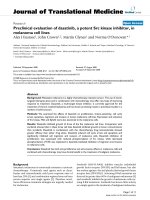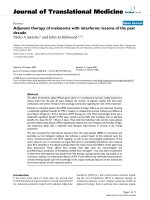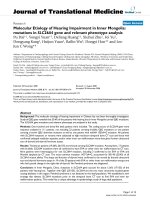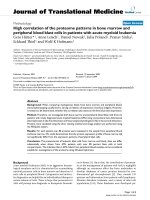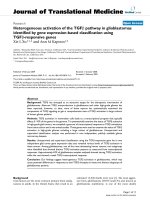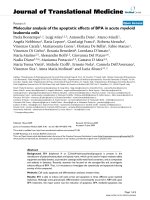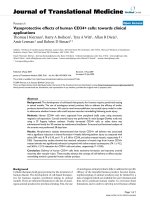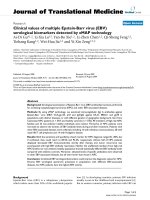báo cáo hóa học: " Vascular consequences of passive Aβ immunization for Alzheimer''''s disease. Is avoidance of "malactivation" of microglia enough?" docx
Bạn đang xem bản rút gọn của tài liệu. Xem và tải ngay bản đầy đủ của tài liệu tại đây (235.85 KB, 4 trang )
BioMed Central
Page 1 of 4
(page number not for citation purposes)
Journal of Neuroinflammation
Open Access
Commentary
Vascular consequences of passive Aβ immunization for Alzheimer's
disease. Is avoidance of "malactivation" of microglia enough?
Steven W Barger*
1,2,3
Address:
1
Department of Geriatrics, University of Arkansas for Medical Sciences, Little Rock, Arkansas 72205 USA,
2
Department of Neurobiology
& Developmental Sciences, University of Arkansas for Medical Sciences, Little Rock, Arkansas 72205 USA and
3
Geriatric Research Education and
Clinical Center, Central Arkansas Veterans Healthcare System, Little Rock, Arkansas 72205 USA
Email: Steven W Barger* -
* Corresponding author
Abstract
The role of inflammation in Alzheimer's disease (AD) has been controversial since its first
consideration. As with most instances of neuroinflammation, the possibility must be considered
that activation of glia and cytokine networks in AD arises merely as a reaction to
neurodegeneration. Active, healthy neurons produce signals that suppress inflammatory events,
and dying neurons activate phagocytic responses in microglia at the very least. But simultaneous
with the arrival of a more complex view of microglia, evidence that inflammation plays a causal or
exacerbating role in AD etiology has been boosted by genetic, physiological, and epidemiological
studies. In the end, it may be that the semantics of "inflammation" and glial "activation" must be
regarded as too simplistic for the advancement of our understanding in this regard. It is clear that
elaboration of the entire repertoire of activated microglia – a phenomenon that may be termed
"malactivation" – must be prevented for healthy brain structure and function. Nevertheless, recent
studies have suggested that phagocytosis of Aβ by microglia plays an important role in clearance of
amyloid plaques, a process boosted by immunization paradigms. To the extent that this clearance
might produce clinical improvements (still an open question), this relationship thus obligates a more
nuanced consideration of the factors that indicate and control the various activities of microglia and
other components of neuroinflammation.
Introduction
Alzheimer's disease (AD) is a progressive degeneration of
neural structure and function that arises in the cerebral
cortex. Behaviorally, affected individuals usually present
with semantic difficulty, followed by a deficiency in epi-
sodic memory, spatial disorientation, sleep disturbances,
depression, agitation, loss of longer memories, general
difficulty with the activities of daily living, and eventually,
death. Neuropathological findings include a relatively
high number of extracellular deposits of the amyloid β-
peptide (Aβ), argyrophillic cytoskeletal aggregates in neu-
rons, accumulation of α-synuclein, loss of synapses, loss
of cholinergic and adrenergic fibers, loss of pyramidal
neurons, and cerebral amyloid angiopathy (CAA) – depo-
sition of Aβ around blood vessels.
Most of the AD correlates above have been connected in
some way to inflammation. For instance, the plaques –
comprised primarily of aggregated amyloid β-peptide
(Aβ) – are inundated with microglia that show profiles of
morphology and gene expression consistent with inflam-
mation. Indeed, if one characterizes any activity by micro-
Published: 11 January 2005
Journal of Neuroinflammation 2005, 2:2 doi:10.1186/1742-2094-2-2
Received: 03 January 2005
Accepted: 11 January 2005
This article is available from: />© 2005 Barger; licensee BioMed Central Ltd.
This is an Open Access article distributed under the terms of the Creative Commons Attribution License ( />),
which permits unrestricted use, distribution, and reproduction in any medium, provided the original work is properly cited.
Journal of Neuroinflammation 2005, 2:2 />Page 2 of 4
(page number not for citation purposes)
glia as a sign of "neuroinflammation," it can be said that
inflammatory responses have been evident in AD for at
least 40 years [1]. But, it was not until the late 1980s that
investigators were willing to express the hypothesis that
inflammatory events were causal or otherwise contribut-
ing to the progression of the disease. Recognition of the
powerful impact of a cytokine like interleukin-1 (IL-1),
elevated in AD microglia, permitted such speculation [2].
Similarly, research accrued showing that primary inflam-
mation could lead to many of the aberrations found in
AD, fueling the consideration that inflammatory events
were seminal [3-5]. Many of the individual molecules pro-
duced by activated microglia and astrocytes are condi-
tional neurotoxins: hydrogen peroxide, glutamate and
other agonists of glutamate receptors, complement com-
ponents, prostanoids. (Nitric oxide from inducible nitric
oxide synthase, produced abundantly in rodent glia, may
be less important in human tissues.) Retrospective epide-
miological studies showed protection against AD – either
in age of onset or rate of progression – by nonsteroidal
antiinflammatory drugs (NSAIDs); such correlations have
now been born out in a prospective study [6]. Perhaps
most compelling, polymorphisms in the genes for proin-
flammatory cytokines are indicative of risk for AD [7].
Despite these indications, there are reasons to believe that
the changes observed in glia and inflammatory cytokines
constitute a compensatory response in AD. Indeed, some
investigators have been reluctant to apply the term
"inflammation" to the constellation of events related to
AD pathology. Some of the cytokines and other gene
products expressed in peripheral sites of inflammation are
present in the AD brain, but there is no apparent vasodi-
lation or extravasation of neutrophils. In general, there
seems to be less of the molecular and cellular behavior
that is responsible for bystander tissue damage in periph-
eral inflammation. This journal was founded partially out
of recognition that "neuroinflammation" is distinct. In
essence, the concept reflects a compromise befitting the
difficult line that must be maintained between effective
cell-mediated immune responses and damage to the pre-
cious components of the CNS. Microglia elevate their
expression of neurotrophic factors under many of the
same conditions in which they show inflammation-
related responses such as phagocytosis, retraction of proc-
esses, release of excitotoxins, and production of IL-1β and
IL-6 and tumor necrosis factor [8]; in fact, the latter
cytokines can have neurotrophic effects themselves [9,10].
Astrocytes deposit proteoglycans around the Aβ deposits
destined to become plaques [11], perhaps sequestering
this neurotoxic peptide from doing its harm. Even the
apparent benefits of NSAIDs can be parsed from their pre-
sumed mechanism of inhibiting cyclooxygenase-2
[12,13](and references therein).
Discussion
Recent experiments with anti-Aβ immunization have
highlighted another beneficial effect of "activated" micro-
glia: removal of Aβ. It has long been recognized that
microglia can efficiently phagocytose and at least partially
degrade Aβ both in vitro and in vivo. But the persistence
of amyloid plaques suggests that microglia are stymied in
this regard during the development of AD or in the depo-
sition of Aβ in mice transgenically engineered to produce
large amounts of the peptide. Introduction of antibodies
recognizing Aβ, either by active vaccination or by passive
immunization (injection of antibodies, typically mono-
clonal), results in removal of some Aβ deposits and/or
prevention of their formation. Although the phenome-
non has been studied most rigorously in the transgenic
mouse models, similar clearance of parenchymal plaques
seems to have occurred in two human subjects that partic-
ipated in an Aβ-vaccine trial [14,15]. And microglia
appear to contribute; Aβ can be readily detected in micro-
glia of immunized mice [16] and was also abundant in
some microglia and related syncitia in the AD trial sub-
jects [14,15]. However, the only reason we are privy to the
effects of the vaccination paradigm in humans is because
these two individuals died after complications of menin-
geal encephalitis – rampant cranial inflammation brought
on by the immunization. This iatrogenic event occurred in
about five percent of the human subjects vaccinated
against Aβ, prompting discontinuation. One interesting
finding from both autopsies is that while parenchymal Aβ
deposits were substantially lower than to be expected in
AD victims, both individuals had relatively high levels of
vascular deposition. This CAA was accompanied by
microhemorrhage in at least one of the subjects [15], con-
sistent with the majority of advanced cases of CAA [17].
Wilcock et al. [18] have now produced evidence that the
appearance of CAA after immunization may represent an
actual increase in this parameter triggered by anti-Aβ anti-
bodies. Furthermore, the investigators also found that the
CAA was accompanied by an increase in hemorrhages –
similar to a previous report [19] – and a vascular accumu-
lation of CD45
+
cells presumed to be microglia. The exper-
imental paradigm was one of passive immunization of
transgenic mice at nearly two years of age, old enough to
have accumulated substantial Aβ deposits. Consistent
with expectations, injection of anti-Aβ antibody dimin-
ished deposits in the parenchyma, even those that were
mature enough to stain with Congo red. However, vascu-
lar deposition of Congo-red staining was elevated by
approximately four-fold in the anti-Aβ-treated animals.
Pfeiffer et al. found similar results in another transgenic
line [19]. Further, Wilcock et al. now show that the
regional accumulation of vascular amyloid was accompa-
nied by an elevated index of hemorrhages and a congrega-
tion of CD45
+
cells, presumed to be microglia [18]. Given
Journal of Neuroinflammation 2005, 2:2 />Page 3 of 4
(page number not for citation purposes)
that stromal microglia show increased signs of activity
and contain Aβ after passive Aβ immunization [20], one
interpretation is that the immunization-induced shift in
amyloid from the parenchyma to the vasculature is medi-
ated by phagocytic microglia attempting to discard the Aβ
into the bloodstream. Such a phenomenon is tenuously
supported by the analogous transport of pyknotic neuro-
nal nuclei to the vasculature by microglia, observed in 3-
D time-lapse videos by Dailey and coworkers [21]. In
those images, microglia are occasionally seen to transfer
the nuclei to another cell, conceivably a perivascular mac-
rophage or dendritic cell. Thus, it is not clear whether the
CD45
+
cells observed by Wilcock and coworkers are
microglia or another cell type. It is also unclear whether
the accumulation of amyloid and inflammatory cells at
the blood vessels represents an arrested state in Aβ clear-
ance or simply a bottleneck in the transport, one that
would eventually yield to complete removal of the pep-
tide. However, the appearance of CAA in the human sub-
jects that suffered from acute encephalitis suggests that the
vascular accumulation is an untoward event, created or
facilitated by inflammation. Another vascular irregularity
caused by Aβ has been linked to inflammatory events in
both transgenic mice and isolated human blood vessels
[22].
The apparent contributions of inflammatory mechanisms
to both Aβ clearance and vascular pathology illustrate a
somewhat unique example of microglial ambivalence.
While many had argued that microglial "activation" by Aβ
was at least partially responsible for AD-associated degen-
eration, others had pointed to microglial phagocytosis as
a desirable consequence of activation. For the purposes of
discussion, the term "malactivation" will be applied here
to microglial activation which produces neurodegenera-
tion. One obvious question is whether there might be a
mode of "activation" that permits phagocytosis while lim-
iting malactivation. In fact, stimulation of Fc receptors –
the antibody receptors that initiate a good deal of anti-
body-triggered phagocytosis – can inhibit cytotoxicity in
macrophages [23]. Similarly, phagocytosis of apoptotic
cells inhibits macrophage expression of proinflammatory
cytokines like IL-1, IL-8, tumor necrosis factor, and several
prostanoids through stimulation of a phosphatidylserine
receptor [24]. Evidence indicates that malactivation
involves the production of reactive oxygen species like
superoxide and peroxide, nitric oxide, and excitotoxins
(glutamate, quinolinate, and D-serine). If these criteria are
germane, malactivation certainly can be suppressed by
specific cytokines, such as transforming growth factor β
(TGFβ) [25]. Although TGFβ has often been characterized
broadly as "anti-inflammatory," it does not inhibit the
phagocytic activity of microglia in a setting where another
"anti-inflammatory" cytokine (IL-4) does [26]. Interest-
ingly, TGFβ1 transgenesis promotes the same apparent
shift of Aβ from parenchyma to vessel that is observed
after Aβ immunization [27].
Conclusions
While some have argued that CAA is of little consequence
in AD [28], the elaboration of the deposition that appears
to occur under conditions of "beneficial inflammation" is
on par with that seen in hereditary cerebral hemorrhage
with angiopathy-Dutch type and is certainly a risk factor
for devastating levels of hemorrhage. If such a response
reflects a broad-acting realignment of cytokine profiles
contingent upon immunization, it behooves careful con-
sideration (and extensive animal testing) for any strategy
for antibody-mediated reduction of Aβ in the AD brain.
List of abbreviations
AD: Alzheimer's disease
Aβ: amyloid β-peptide
CAA: cerebral amyloid angiopathy
IL-1, -6, -8: interleukin-1, -6, -8
NSAID: nonsteroidal antiinflammatory drug
TGFβ: transforming growth factor β
Competing interests
The author(s) declare that they have no competing inter-
ests.
Acknowledgements
The author appreciates salary support from NIH funds 1R01 NS046439,
1R01 AG17498, 2P01AG12411-06A10003, and 5R01HD037989
References
1. Terry RD, Gonatas NK, Weiss M: Ultrastructural studies in
Alzheimer's presenile dementia. Am J Pathol 1964, 44:269-287.
2. Griffin WST, Stanley LC, Ling C, White L, MacLeod V, Perrot LJ,
White CLIII, Araoz C: Brain interleukin 1 and S-100 immunore-
activity are elevated in Down syndrome and Alzheimer dis-
ease. Proc Natl Acad Sci USA 1989, 86:7611-7615.
3. Willard LB, Hauss-Wegrzyniak B, Danysz W, Wenk GL: The cyto-
toxicity of chronic neuroinflammation upon basal forebrain
cholinergic neurons of rats can be attenuated by glutamater-
gic antagonism or cyclooxygenase-2 inhibition. Exp Brain Res
2000, 134:58-65.
4. Li Y, Liu L, Barger SW, Griffin WS: Interleukin-1 mediates path-
ological effects of microglia on tau phosphorylation and on
synaptophysin synthesis in cortical neurons through a p38-
MAPK pathway. J Neurosci 2003, 23:1605-1611.
5. Craft JM, Van Eldik LJ, Zasadzki M, Hu W, Watterson DM: Ami-
nopyridazines attenuate hippocampus-dependent behavio-
ral deficits induced by human beta-amyloid in a murine
model of neuroinflammation. J Mol Neurosci 2004, 24:115-122.
6. Zandi PP, Anthony JC, Hayden KM, Mehta K, Mayer L, Breitner JC:
Reduced incidence of AD with NSAID but not H2 receptor
antagonists: the Cache County Study. Neurology 2002,
59:880-886.
7. Mrak RE, Griffin WS: Interleukin-1 and the immunogenetics of
Alzheimer disease. J Neuropathol Exp Neurol 2000, 59:471-476.
Publish with Bio Med Central and every
scientist can read your work free of charge
"BioMed Central will be the most significant development for
disseminating the results of biomedical research in our lifetime."
Sir Paul Nurse, Cancer Research UK
Your research papers will be:
available free of charge to the entire biomedical community
peer reviewed and published immediately upon acceptance
cited in PubMed and archived on PubMed Central
yours — you keep the copyright
Submit your manuscript here:
/>BioMedcentral
Journal of Neuroinflammation 2005, 2:2 />Page 4 of 4
(page number not for citation purposes)
8. Elkabes S, DiCicco-Bloom EM, Black IB: Brain microglia/macro-
phages express neurotrophins that selectively regulate
microglial proliferation and function. J Neurosci 1996,
16:2508-2521.
9. Hama T, Kushima Y, Miyamoto M, Kubota M, Takei N, Hatanaka H:
Interleukin-6 improves the survival of mesencephalic cate-
cholaminergic and septal cholinergic neurons from postna-
tal, two-week-old rats in cultures. Neuroscience 1991,
40:445-452.
10. Barger SW, Hörster D, Furukawa K, Goodman Y, Kriegelstein J, Matt-
son MP: Tumor necrosis factors a and b protect neurons
against amyloid b-peptide toxicity: Evidence for involve-
ment of a kB-binding factor and attenuation of peroxide and
Ca2+ accumulation. Proc Natl Acad Sci USA 1995, 92:9328-9332.
11. Shioi J, Pangalos MN, Ripellino JA, Vassilacopoulou D, Mytilineou C,
Margolis RU, Robakis NK: The Alzheimer amyloid precursor
proteoglycan (appican) is present in brain and is produced by
astrocytes but not by neurons in primary neural cultures. J
Biol Chem 1995, 270:11839-11844.
12. Aisen PS, Schafer KA, Grundman M, Pfeiffer E, Sano M, Davis KL, Far-
low MR, Jin S, Thomas RG, Thal LJ: Effects of rofecoxib or
naproxen vs placebo on Alzheimer disease progression: a
randomized controlled trial. Jama 2003, 289:2819-2826.
13. Weggen S, Eriksen JL, Sagi SA, Pietrzik CU, Ozols V, Fauq A, Golde
TE, Koo EH: Evidence that nonsteroidal anti-inflammatory
drugs decrease amyloid beta 42 production by direct modu-
lation of gamma-secretase activity. J Biol Chem 2003,
278:31831-31837.
14. Nicoll JA, Wilkinson D, Holmes C, Steart P, Markham H, Weller RO:
Neuropathology of human Alzheimer disease after immuni-
zation with amyloid-beta peptide: a case report. Nat Med
2003, 9:448-452.
15. Ferrer I, Boada Rovira M, Sanchez Guerra ML, Rey MJ, Costa-Jussa F:
Neuropathology and pathogenesis of encephalitis following
amyloid-beta immunization in Alzheimer's disease. Brain
Pathol 2004, 14:11-20.
16. Games D, Bard F, Grajeda H, Guido T, Khan K, Soriano F, Vasquez N,
Wehner N, Johnson-Wood K, Yednock T, Seubert P, Schenk D: Pre-
vention and reduction of AD-type pathology in PDAPP mice
immunized with A beta 1-42. Ann N Y Acad Sci 2000,
920:274-284.
17. Pfeifer LA, White LR, Ross GW, Petrovitch H, Launer LJ: Cerebral
amyloid angiopathy and cognitive function: the HAAS
autopsy study. Neurology 2002, 58:1629-1634.
18. Wilcock DM, Rojiani A, Rosenthal A, Subbarao S, Freeman MJ, Gor-
don MN, Morgan D: Passive immunotherapy against Abeta in
aged APP-transgenic mice reverses cognitive deficits and
depletes parenchymal amyloid deposits in spite of increased
vascular amyloid and microhemorrhage. J Neuroinflammation
2004, 1:24.
19. Pfeifer M, Boncristiano S, Bondolfi L, Stalder A, Deller T, Staufenbiel
M, Mathews PM, Jucker M: Cerebral hemorrhage after passive
anti-Abeta immunotherapy. Science 2002, 298:1379.
20. Wilcock DM, Rojiani A, Rosenthal A, Levkowitz G, Subbarao S,
Alamed J, Wilson D, Wilson N, Freeman MJ, Gordon MN, Morgan D:
Passive amyloid immunotherapy clears amyloid and tran-
siently activates microglia in a transgenic mouse model of
amyloid deposition. J Neurosci 2004, 24:6144-6151.
21. Petersen MA, Dailey ME: Diverse microglial motility behaviors
during clearance of dead cells in hippocampal slices. Glia 2004,
46:195-206.
22. Paris D, Humphrey J, Quadros A, Patel N, Crescentini R, Crawford F,
Mullan M: Vasoactive effects of A beta in isolated human cer-
ebrovessels and in a transgenic mouse model of Alzheimer's
disease: role of inflammation. Neurol Res 2003, 25:642-651.
23. Virgin HW, Kurt-Jones EA, Wittenberg GF, Unanue ER: Immune
complex effects on murine macrophages. II. Immune com-
plex effects on activated macrophages cytotoxicity, mem-
brane IL 1, and antigen presentation. J Immunol 1985,
135:3744-3749.
24. Fadok VA, Bratton DL, Rose DM, Pearson A, Ezekewitz RA, Henson
PM: A receptor for phosphatidylserine-specific clearance of
apoptotic cells. Nature 2000, 405:85-90.
25. Suzumura A, Sawada M, Yamamoto H, Marunouchi T: Transform-
ing growth factor-beta suppresses activation and prolifera-
tion of microglia in vitro. J Immunol 1993, 151:2150-2158.
26. Chan A, Magnus T, Gold R: Phagocytosis of apoptotic inflamma-
tory cells by microglia and modulation by different
cytokines: mechanism for removal of apoptotic cells in the
inflamed nervous system. Glia 2001, 33:87-95.
27. Wyss-Coray T, Lin C, Yan F, Yu GQ, Rohde M, McConlogue L,
Masliah E, Mucke L: TGF-beta1 promotes microglial amyloid-
beta clearance and reduces plaque burden in transgenic
mice. Nat Med 2001, 7:612-618.
28. Castellani RJ, Smith MA, Perry G, Friedland RP: Cerebral amyloid
angiopathy: major contributor or decorative response to
Alzheimer's disease pathogenesis. Neurobiol Aging 2004,
25:599-602; discussion 603-4.
